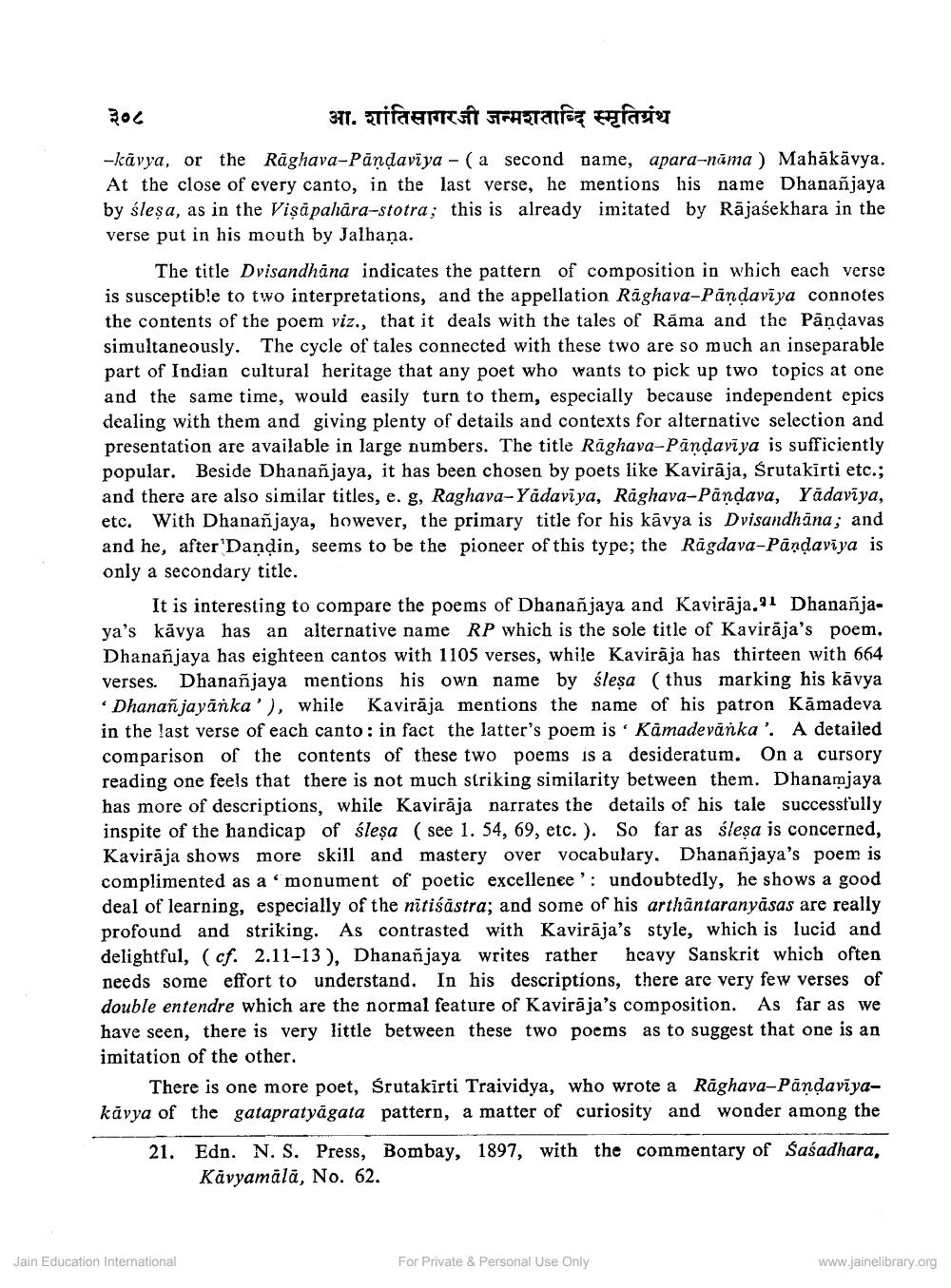Book Title: Dhananjaya and his Dwi Sadhana Author(s): A N Upadhye Publisher: Z_Acharya_Shantisagar_Janma_Shatabdi_Mahotsav_Smruti_Granth_012022.pdf View full book textPage 6
________________ ROC आ. शांतिसागरजी जन्मशताब्दि स्मृतिग्रंथ -kavya, or the Rāghava-Pandavīya - (a second name, apara-nāma ) Mahākāvya. At the close of every canto, in the last verse, he mentions his name Dhanañjaya by ślesa, as in the Visapahāra-stotra; this is already imitated by Rajasekhara in the verse put in his mouth by Jalhaņa. The title Dvisandhāna indicates the pattern of composition in which each verse is susceptible to two interpretations, and the appellation Raghava-Pāndavīya connotes the contents of the poem viz., that it deals with the tales of Rāma and the Pandavas simultaneously. The cycle of tales connected with these two are so much an inseparable part of Indian cultural heritage that any poet who wants to pick up two topics at one and the same time, would easily turn to them, especially because independent epics dealing with them and giving plenty of details and contexts for alternative selection and presentation are available in large numbers. The title Rāghava-Pandavīya is sufficiently popular. Beside Dhanañjaya, it has been chosen by poets like Kavirāja, Śrutakirti etc.; and there are also similar titles, e. g, Raghava-Yadavīya, Raghava-Pandava, Yadavīya, etc. With Dhanañjaya, however, the primary title for his kāvya is Dvisandhāna; and and he, after 'Dandin, seems to be the pioneer of this type; the Rāgdava-Pandaviya is only a secondary title. It is interesting to compare the poems of Dhananjaya and Kavirāja.91 Dhananjaya's kāvya has an alternative name RP which is the sole title of Kavirāja's poem. Dhananjaya has eighteen cantos with 1105 verses, while Kaviraja has thirteen with 664 verses. Dhananjaya mentions his own name byśleşa (thus marking his kāvya Dhananjayānka'), while Kavirāja mentions the name of his patron Kāmadeva in the last verse of each canto: in fact the latter's poem is Kamadevānka'. A detailed comparison of the contents of these two poems is a desideratum. On a cursory reading one feels that there is not much striking similarity between them. Dhanamjaya has more of descriptions, while Kaviraja narrates the details of his tale successfully inspite of the handicap of śleşa (see 1. 54, 69, etc.). So far as śleşa is concerned, Kavirāja shows more skill and mastery over vocabulary. Dhanañjaya's poem is complimented as a monument of poetic excellence': undoubtedly, he shows a good deal of learning, especially of the nitiśästra; and some of his arthāntaranyāsas are really profound and striking. As contrasted with Kavirāja's style, which is lucid and delightful, (cf. 2.11-13), Dhananjaya writes rather heavy Sanskrit which often needs some effort to understand. In his descriptions, there are very few verses of double entendre which are the normal feature of Kavirāja's composition. As far as we have seen, there is very little between these two poems as to suggest that one is an imitation of the other. There is one more poet, śrutakirti Traividya, who wrote a Rāghava-Pāndavīyakävya of the gatapratyāgata pattern, a matter of curiosity and wonder among the 21. Edn. N. S. Press, Bombay, 1897, with the commentary of Saśadhara, Kavyamala, No. 62. Jain Education International For Private & Personal Use Only www.jainelibrary.orgPage Navigation
1 ... 4 5 6 7 8
